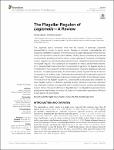The Flagellar Regulon of Legionella—A Review
Appelt, Sandra
Heuner, Klaus
The Legionella genus comprises more than 60 species. In particular, Legionella pneumophila is known to cause severe illnesses in humans. Legionellaceae are ubiquitous inhabitants of aquatic environments. Some Legionellaceae are motile and their motility is important to move around in habitats. Motility can be considered as a potential virulence factor as already shown for various human pathogens. The genes of the flagellar system, regulator and structural genes, are structured in hierarchical levels described as the flagellar regulon. Their expression is modulated by various environmental factors. For L. pneumophila it was shown that the expression of genes of the flagellar regulon is modulated by the actual growth phase and temperature. Especially, flagellated Legionella are known to express genes during the transmissive phase of growth that are involved in the expression of virulence traits. It has been demonstrated that the alternative sigma-28 factor is part of the link between virulence expression and motility. In the following review, the structure of the flagellar regulon of L. pneumophila is discussed and compared to other flagellar systems of different Legionella species. Recently, it has been described that Legionella micdadei and Legionella fallonii contain a second putative partial flagellar system. Hence, the report will focus on flagellated and non-flagellated Legionella strains, phylogenetic relationships, the role and function of the alternative sigma factor (FliA) and its anti-sigma-28 factor (FlgM).
Dateien zu dieser Publikation
Keine Lizenzangabe

